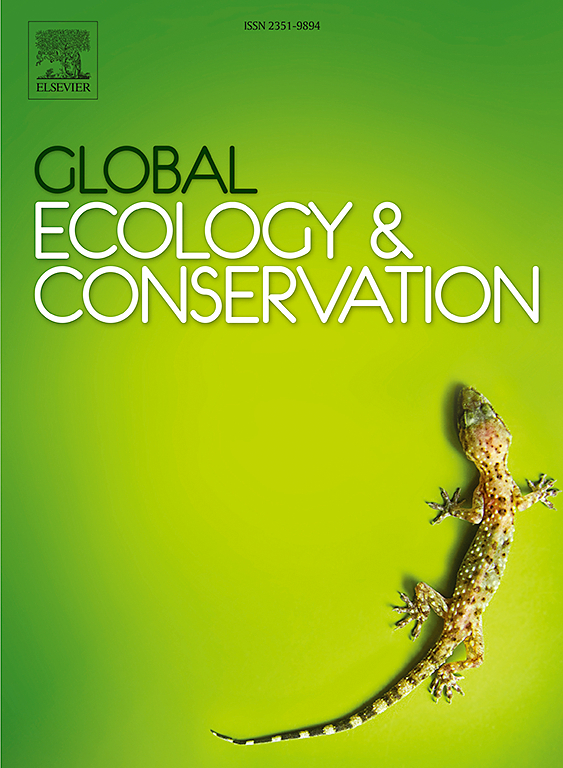Native tropical forest species regeneration in non-native eucalyptus tree plantations along the agricultural landscapes of south-eastern Malagasy highlands
IF 3.5
2区 环境科学与生态学
Q1 BIODIVERSITY CONSERVATION
引用次数: 0
Abstract
The plantation of fast-growing exotic species is an increasing phenomenon in tropical regions, with eucalyptus being the most prevalent species. Eucalyptus plantations (EP) have the potential to facilitate the regeneration of native species; however, in some cases, they may also hinder this process. The factors influencing the effects of EP on the regeneration of native species remain poorly understood. This study aims to identify the conditions that make these plantations favorable or unfavorable for the regeneration of native species. We investigated EP in agricultural landscapes in the south-eastern Malagasy highlands, located at the edge of dense rainforest. Floristic surveys were conducted in 20 EP situated at varying distances from natural forest fragments (near<950 m, in forest edge; intermediate/far>950 m in savannah). The understory of EP was characterised by a high abundance of native species. However, they were found to be more abundant and diverse in the intermediatestory of EP located near natural forest fragments. These native species are still in the early stages of plant succession, as they have essentially occupied the understory of the EP and contribute minimally to the basal area. The basal areas of native species in EP sites adjacent to natural forests are, in fact, comparable to those found in 0–5-year-old slash-and-burn fallows, which also occur on the periphery of natural forests. EP established in savannahs away from natural forests can act as catalysts for the natural regeneration of native species that would not occur without them. Conversely, EP on the edge of or within natural forests slow down the natural regeneration of native species, which would develop more rapidly in their absence. This study emphasises the significance of landscape spatial context in optimising the role of EP in the conservation and restoration of tropical forest ecosystems.
马达加斯加东南部高地农业景观沿线非原生桉树人工林的原生热带森林物种更新
在热带地区,速生外来树种的种植越来越普遍,尤加利是最普遍的树种。桉树人工林(EP)具有促进本地物种更新的潜力;然而,在某些情况下,它们也可能阻碍这一进程。影响EP对本地物种更新影响的因素尚不清楚。本研究旨在确定这些人工林有利于或不利于本地物种更新的条件。我们调查了马达加斯加东南部高地农业景观中的生态环境效应,该地区位于茂密雨林的边缘。在距离天然林破碎片近950 m的20个EP中进行了植物区系调查;中级/远>;950 萨凡纳米)。青藏高原林下植被具有丰富的本地物种的特点。然而,在靠近天然林碎片的EP中期,它们的数量和种类更为丰富。这些本地物种仍处于植物演替的早期阶段,因为它们基本上占据了EP的林下植被,对基底面积的贡献很小。事实上,毗邻天然林的生态保护地的原生物种基部面积与0 - 5年的刀耕火种休耕区相当,后者也出现在天然林的外围。在远离天然林的热带稀树草原上建立的生态系统可以作为本地物种自然再生的催化剂,没有它们就不会发生这种再生。相反,天然林边缘或天然林内的EP减缓了本地物种的自然更新,而在没有它们的情况下,本地物种的发展速度会更快。本研究强调了景观空间背景在优化EP在热带森林生态系统保护和恢复中的作用中的重要意义。
本文章由计算机程序翻译,如有差异,请以英文原文为准。
求助全文
约1分钟内获得全文
求助全文
来源期刊

Global Ecology and Conservation
Agricultural and Biological Sciences-Ecology, Evolution, Behavior and Systematics
CiteScore
8.10
自引率
5.00%
发文量
346
审稿时长
83 days
期刊介绍:
Global Ecology and Conservation is a peer-reviewed, open-access journal covering all sub-disciplines of ecological and conservation science: from theory to practice, from molecules to ecosystems, from regional to global. The fields covered include: organismal, population, community, and ecosystem ecology; physiological, evolutionary, and behavioral ecology; and conservation science.
 求助内容:
求助内容: 应助结果提醒方式:
应助结果提醒方式:


